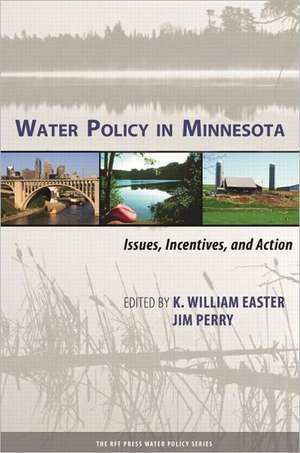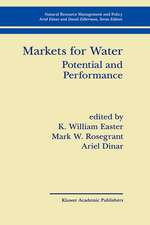Water Policy in Minnesota: Issues, Incentives, and Action: RFF Press Water Policy Series
Editat de K. William Easter, Jim Perryen Limba Engleză Hardback – 22 iun 2011
| Toate formatele și edițiile | Preț | Express |
|---|---|---|
| Paperback (1) | 244.53 lei 6-8 săpt. | |
| Taylor & Francis – 14 oct 2024 | 244.53 lei 6-8 săpt. | |
| Hardback (1) | 949.78 lei 6-8 săpt. | |
| Taylor & Francis – 22 iun 2011 | 949.78 lei 6-8 săpt. |
Preț: 949.78 lei
Preț vechi: 1158.27 lei
-18% Nou
Puncte Express: 1425
Preț estimativ în valută:
181.76€ • 197.37$ • 152.68£
181.76€ • 197.37$ • 152.68£
Carte tipărită la comandă
Livrare economică 23 aprilie-07 mai
Preluare comenzi: 021 569.72.76
Specificații
ISBN-13: 9781617260865
ISBN-10: 161726086X
Pagini: 336
Dimensiuni: 156 x 234 x 23 mm
Greutate: 0.57 kg
Ediția:1
Editura: Taylor & Francis
Colecția Routledge
Seria RFF Press Water Policy Series
Locul publicării:Oxford, United Kingdom
ISBN-10: 161726086X
Pagini: 336
Dimensiuni: 156 x 234 x 23 mm
Greutate: 0.57 kg
Ediția:1
Editura: Taylor & Francis
Colecția Routledge
Seria RFF Press Water Policy Series
Locul publicării:Oxford, United Kingdom
Public țintă
AcademicCuprins
Foreword I. Introduction 1. Time for Action II. Overview of Minnesota's Waters and Laws 2. Interstate and International Water Management3. Minnesota's Landscape Characteristics: The Implication for Water4. Implementing the Federal Water Pollution Control Act and Minnesota's Clean Water Legacy Act 5. Minnesota Water Law: A Unique Hybrid III. Managing the Waters as Biophysical Resources 6. Local Scale Institutions: Lake Management Associations and Watershed Districts 7. Policy Decisions and the Changing Face of Wetlands 8. Groundwater Policy at State and Local Levels: The Science-Policy Linkage IV. Managing Competing Water Uses 9. Urbanization and Water Resources: Policy Implementation in an Era of Austerity 10. Navigation, Dredging, and Protection: The Checkered History of Channel Maintenance 11. Water-Quality: Trading and the Effects of Agricultural and Energy Policy V. Emerging Issues 12. The Impact of Climate Change on Distribution and Use of Water 13. Management of Invasive Aquatic Species 14. Flooding and Flood Management 15. Policy Complexity and Competing Uses in a 'Water Rich' StateVI. Moving Toward a Progressive Future 16. Finding a Path to Water Sustainability 17. Lessons and Opportunities for Engagement by Present and Future Policy-Makers
Notă biografică
K. William Easter has worked on the economics of a wide range of water resource problems internationally and domestically over the past 50 years. He is currently professor of applied economics at the University of Minnesota. Jim Perry has been an active water resource professional for more than 40 years and is currently professor and head of the Department of Fisheries, Wildlife and Conservation Biology at the University of Minnesota.
Descriere
The book will be an excellent guide for policymakers and decision makers who are interested in learning about alternative approaches to water management. Non-governmental organizations interested in stimulating effective water quality policy will also find this a helpful resource. Finally, there are similarities between the lessons learned in Minnesota and the goals of water policy in several other states and nations, where there are competing uses of water for households, agriculture, recreation, and navigation.






























